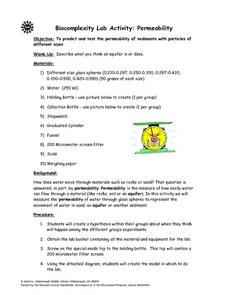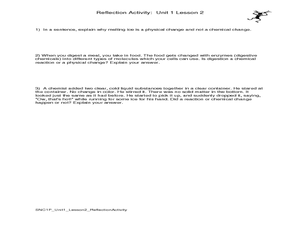Curated OER
Acid Rain
Students identify the causes and effects of acid rain. Using the internet, they research pollution sources in their local area and by collecting rain samples and testing the pH. In groups, they develop their own plan urging local...
Curated OER
Jumping Frogs
Students create a jumping frog out of construction paper, close pins and pipe cleaners. They predict how far they think their frog jump and then test it out to see how close or far away they were from their prediction.
Curated OER
Pie Crust Experiment
This experiment can be used as a pre-assessment to see what experience and knowledge the high schoolers have in preparing pies. They identify the difference in taste, flavor, texture and appearance as they substitute different...
Curated OER
Communication in Bees
Eighth graders identify and interpret a scientific investigation and a hypothesis through experimentation and testing a hypothesis. They identify what scientists hypothesized about the communication of stingless bees. Finally, 8th...
Curated OER
Risks and Consequences
Fourth graders explore situations and weigh the risks and consequences in each decision. After reading given narratives, 4th graders analyze the test to determine the cause and effect of various events. They determine if the risk was...
Curated OER
GDP and Standard of Living
Seventh graders discuss the GDP and Middle Eastern nations. In this standard of living instructional activity, 7th graders complete a worksheet during a lecture on the GDP. Students identify the impact of the GDP on a country and reasons...
Curated OER
Inside A seed
Learners examine the inside of a seed to see the beginnings of a plant. They identify the elements that plants need to grow and survive. They grow their seeds in the classroom.
Curated OER
How Are Boundaries Made, Kept, Broken?
Students examine the different perspectives of Igbo women. They simulate a silent debate in response to the question, "Is the Igbo society sexist?" They write their response to the question and exchange papers with their partner as the...
Curated OER
Outdoor Explorations: Mystery Plot Vacant Lot
Students utilize observations skills as they work together in groups to solve a mystery. They discuss and perform strategies to solve mysteries that occurred on a vacant lot. Students use a field guide to identify plants and animals...
Curated OER
Up, Up and Away
Third graders are presented with the problem of: Do all liquids evaporate at the same rate? The lesson contains adequate background information for the teacher. They participate in a lab experiment in order to test the scientific...
Curated OER
Environmental Risk Management
Middle schoolers investigate the concepts related to managing the environment. They conduct research using a variety of resources. Students cite examples of different organisms that have been targeted to become endangered. They answer...
Curated OER
OaxacaTurtles
Pupils identify types of turtles off the coast of Oaxaca. They become acquainted with the Mexican Turtle Center. They create a project (mural, map, panel discussion, logo/design) to communicate researched information.
Curated OER
Nutrition in Space
Students discover the importance of a healthy diet during space travel and examine the physiological changes astronauts experience while in space. In groups, they develop questions to determine an astronaut's food intake and identify...
Curated OER
Music Box
Students work together to build a music box. They create figures that move when a song plays. They answer discussion questions to complete the lesson.
Curated OER
Anna's Dilemma
Young scholars read a scenerio about people who lived in Germany during Nazi rule. As a class, they discuss the situations the character finds herself in and identify her responsiblities to her family. They answer discussion questions...
Curated OER
Biocomplexity Lab Activity: Permeability
Learners identify how water moves through materials such as rocks or sand. Students measure the permeability of water through glass spheres to represent the movement of water in sand, an aquifer, or another sediment. During the...
Curated OER
CO2 and Mass
Students determine if carbon dioxide has mass. In groups, they use a standard set of materials to test the carbon dioxide. They answer questions on their lab sheet and discuss them as a class.
Curated OER
Iiizzy is Iiicky Sticky!
Students answer a series of questions about the different sounds that the letter I makes. They observe a picture about a girl and the letter I. They practice a tongue twister with the different sounds of I. They practice writing the...
Curated OER
Addendum to the Written Curriculum: Measuring Solids
Learners use standard rulers to measure the length of common classroom items - such as pencils, books, desk tops - in inches and centimeters, and measure weight in pounds. They also answer math questions, such as "How long is the front...
Curated OER
Physical and Chemical Changes
Learners differentiate physical and chemical changes. In this chemistry lesson, students identify five indicators that a chemical change took place. They complete a reflection journal at the end of the activity.
Curated OER
Sensor Challenge
Students develop a pseudo code flowchart for their robotic program. In this physics lesson, students construct a robot that can navigate through certain obstacles. They test their robot and present them to class.
Curated OER
Robot Olympics
Young scholars design a robot based on given requirements. In this technology lesson, student test whether their robots can perform certain tasks. They present and discuss their program design.
Curated OER
Outdoor Seed Sowing
First graders identify vegetables and flowers that can be grown from seed. In this seed sowing instructional activity, student learn the correct spacing and planting of various types of seeds. Students label plants.
Curated OER
Why Are Some Nations Wealthy?
Students, in groups, examine data from several nations regarding size, natural resources, and population. Using these data, they rank the nations, try to identify them, and predict whether each nation is rich or poor.























